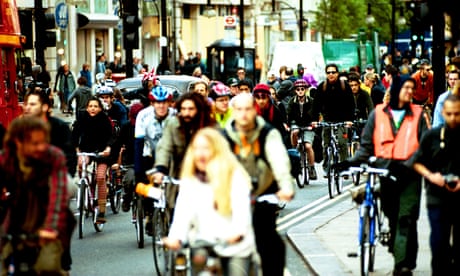
Thirteen years ago, riding through central London on my way to meet a friend one evening, I found myself surrounded by hundreds of cyclists, some blaring horns, one popping wheelies, and even someone covered in lights, thundering out drum’n’bass from a mobile sound system.
In spite of being overdressed in a shirt and my best trousers, I was taken by the spontaneous solidarity of this diverse group, who I later found was mostly made up of strangers.
Having been swept along in their pack, we made our way to the West End as other traffic momentarily came to a halt to let us pass, while perplexed tourists and shoppers looked on.
This was my first experience of Critical Mass, a monthly, leaderless event held around the world, which promotes safer cycling by riding in numbers.
As a nervous cyclist getting used to riding in London, participating in a “rideout” gave me a rare chance to briefly experience what roads in the capital could be like without cars. It was liberating.
This Sunday, hundreds of cyclists are expected to take part in the 30th anniversary of the first London event. Just like in 1994, the rolling demonstration will reiterate a message that cyclists have an equal right to use the road and that they should be able to ride in safety. Although numbers have been falling, about 100 cyclists still die on British roads each year, according to government data.
Inspired by rides first held in the US, Critical Mass tries to set off from the same starting point on the last Friday of every month; in London it is the South Bank, under Waterloo Bridge.
A mix of riders turn up, from cycling activists and environmentalists to those who just want to ride for fun.
There is no planned route; the pack simply follows riders who happen to be at the front. By forming a “critical mass” and riding slowly around a city, riders take up as much road as is needed to keep everybody safe.
A Critical Mass website explains: “Critical Mass is not an organisation or group, but an idea or tactic, Critical Mass allows people to reclaim cities with their bikes, just by getting together and outnumbering the cars on the road”
There is no question that rides are disruptive in their nature. At roundabouts and junctions, a few “corkers” will move out to stop traffic coming in from sidestreets so the pack can stick together. Sometimes, the disruption leads to arguments, as I witnessed on my first ride. Fortunately, a standoff between a young rider and a motorist was defused quickly.
The rides often last for a few hours and their noise and colour give them a reputation for being a bit lively.
That Critical Mass London still exists is somewhat of an achievement given that there have been high-profile attempts to restrict or even ban it. In 2007 moves to outlaw it unless its route was notified to the police in advance were overturned when the House of Lords allowed an appeal against a previous ruling by the court of appeal.
The law lords held that the event, which had no organisers or set route and proceeded on a “follow my leader” basis, was not governed by the Public Order Act 1986.
It is not easy to measure what 30 years of Critical Mass London rideouts have achieved, but its participants would probably want to believe that it has helped raise the profile of cyclists. They would also argue that they have helped change the stereotype that cyclists on the capital’s roads are still the minority.
The event endures, and this weekend a diverse group of people will celebrate their right to use the road safely and in an environmentally friendly manner. In a symbolic act of defiance, many will also get off their bikes during the ride to hold their bikes above their heads and join in with a traditional “bike lift” or “bike salute” (probably to a backdrop of car horns blaring).